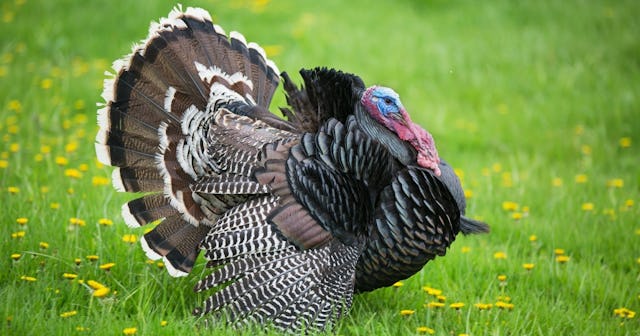10 Totally Terrific Turkey Coloring Pages Your Kids Will Gobble Up

Let’s be real: We love Halloween, but by the time October rolls around, all we’re thinking about is Thanksgiving. We want to eat a full Thanksgiving meal, tell Thanksgiving jokes and “Turkey Day” riddles, and, yes, gobble like that goofy bird, the turkey. Not only does turkey taste significantly better than chicken, but you’ll soon find out that one of our founding fathers actually believed it was much smarter and more honorable, too. And, while we’re in the Turkey Day mood, why not try out some turkey coloring pages, too? These fun pages would be great to print and leave at the kids’ table in hopes of extending the adult meal a little longer.
Plus, there are so many skills your littlest color-ers can pick up from this DIY activity to help them get ready for kindergarten. And if they finish these but you still want to stretch out your nice, quiet Thanksgiving dinner? Print out more coloring pages! Expand the farm coloring pages theme with clucky chicken coloring pages or cow coloring pages. You could also go for the always-familiar symbol of the fall and bring out the scarecrow coloring pages. While many people tend to think of the scarecrow as only being appropriate during Halloween, the truth is that farmers use them all year long.
For now, here are 10 super-cute turkey coloring pages — and a few turkey facts to share over the stuffing!
Free Printable Turkey Coloring Pages
Turkey Page No. 1
Did you know that female turkeys, just like chickens, are called hens? Male turkeys, however, are called gobblers. Their name comes from the distinct gobbling sound they use to attract the hen’s attention. And did you know gobblers court female turkeys in groups? Only one gobbler gets the girl, but talk about wingmen!
Turkey Page No. 2
Turkeys don’t only communicate in gobbles, however. They also yelp and purr. They even make a sound called a “kee-kee.” Turns out they’re pretty talkative creatures!
Turkey Page No. 3
Many people believe you can tell the difference between a gobbler and hen by their features, like the snood and wattle. In truth, both genders of turkeys have these features. But you can tell a turkey’s sex by its size… and by its droppings.
Turkey Page No. 4
But wait, what’s this about a “snood and wattle”? A turkey’s snood is the dangling bit of flesh that grows down the bird’s forehead, while the wattle is the bright bumpy skin that hangs from their chin. A longer snood apparently makes gobblers more attractive to hens.
Turkey Page No. 5
Think you can catch a turkey with your bare hands? Think again! Turkeys run at around 25 miles per hour and have a max flight speed of 55 miles per hour. That’s highway speed, y’all. So, if you ever find yourself being chased by a turkey, wave your hands or open an umbrella in their direction to get them to back off.
Turkey Page No. 6
A turkey egg gestates for about 28 days. Once they hatch, a baby turkey is called a poult. Poults eat a little bit of everything, from berries and seeds to small ground animals! If you’re wondering how turkeys manage to spot such small food sources, well, their vision is way better than that of humans. It’s actually three times better, and they can see up to 270 degrees.
Turkey Page No. 7
Though people originally domesticated turkeys in Mexico, the bird gets its name from the country of Turkey. Uh, why? There’s no exact or definitive answer, but historians believe the most solid origin explanation is this — in the time of early America, many Europeans classified anything exotic as “Turkish.”
Turkey Page No. 8
Ever see a turkey in the wild? While wild turkeys are often skinnier and have much darker feathers than domestic turkeys, the two carry the exact same DNA. They’ve each just adapted to their different environments.
Turkey Page No. 9
Want to find turkeys and turkey eggs in the wild? Look up! While turkeys, of course, can be found at ground level, they often tend to roost high in trees. This keeps them (and their broods) safer from predators.
Turkey Page No. 10
That story of Benjamin Franklin suggesting that a turkey should be our National bird? It’s not true at all! It is true, however, that he didn’t much care for the eagle. According to Smithsonian Magazine, Franklin also suggested that the turkey is “more respectable” and “a bird of courage.”
Click here to print all of the turkey coloring pages at once!
This article was originally published on